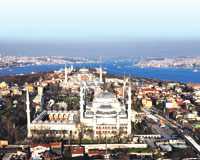The number of publications on İstanbul has soared with the city being chosen among the 2010 European Capital of Culture picks this year.
 A large number of books have been published with a variety of content and photography. One of the latest publications in this area that came out of İstanbul Chamber of Commerce publications, called “Sanctuaries of İstanbul from the Sky,” offers aerial images of various places of worship that constitute some of the city’s most important historic landmarks. The pictures in the 255-page book, or album, were taken by Orhan Durgut, one of Turkey’s most famous aerial photographers.
A large number of books have been published with a variety of content and photography. One of the latest publications in this area that came out of İstanbul Chamber of Commerce publications, called “Sanctuaries of İstanbul from the Sky,” offers aerial images of various places of worship that constitute some of the city’s most important historic landmarks. The pictures in the 255-page book, or album, were taken by Orhan Durgut, one of Turkey’s most famous aerial photographers.
The book, produced for print by Cihan Yapım, also includes opinions from the city’s religious leaders including İstanbul Mufti Mustafa Çağrıcı, Greek Orthodox Patriarch Bartholomew I, deputy patriarch of the Armenian Patriarchate based in İstanbul Archbishop Aram Ateşyan and Chief Rabbi of Turkey Rav İsak Haleva.
In his evaluation of the city’s sanctuaries, Professor Çağrıcı emphasizes the diversity of the city. “In addition to several characteristics, İstanbul is a special city also for embracing different religious beliefs, the symbols and values of these beliefs for centuries. The spiritual and religious richness of the city has further increased since its conquest [by the Ottomans]. Since 1453, the sanctuaries of Muslims and Christians in İstanbul have existed and developed together.”
Patriarch Bartholomew I says of İstanbul, “With her history of thousands of years, İstanbul is just like the city of spirituality where the most splendid sanctuaries are located one on the top of the other and next to each other.”
Rabbi Haleva describes the city’s religious sites, saying: “Undoubtedly the sanctuaries of İstanbul are the most important components creating the specific mystery of this city. In other words, the sanctuaries have an important role in activating the imagination of the people in İstanbul’s silhouette, with its beauty different through the day and nights.”
Archbishop Ateşyan says İstanbul has a lot to offer but for only those who want to own, see and understand the city. “The sanctuaries are among the top of the most important structures constituting this whole.”
The Hagia Sophia Museum, one of the many religious sanctuaries included in the album, has withstood the test of 15 centuries. It is one of the most important edifices of Byzantine architecture in the city with its huge dome, considered a masterpiece in art history. Hagia Sophia was built in the center of the historic peninsula by Emperor Justinian I as a patriarchate cathedral between A.D. 532 and 537. The dome transition and load bearing system of Hagia Sophia are considered significant milestones in the history of architecture.
Another İstanbul mosque included in the book is naturally the Sultan Ahmet Mosque, also known as the Blue Mosque. It is one of the most important edifices in the city and perhaps its figure is the most recognizable in the skyline of the historical peninsula with its six minarets extending into the heavens. It was built by architect Sedefkar Mehmet Ağa under orders of Sultan Ahmet I in the period between 1609 and 1616. One of the key features of this mosque is the more than 20,000 pieces of blue, green and white İznik tiles used in its interior decoration.
The beautiful red roof of the spectacular St. Antoine Catholic Church located in the Beyoğlu area is all the more striking in the aerial image. This church will be on the left on İstiklal Street as you walk toward the Tünel area from the Taksim Square. It is the largest church with the largest congregation in the city. It was initially built in 1725 to provide religious services to the city’s Catholics. However, originally it was not made of red bricks as it currently is. The currently standing neo-gothic style, reinforced concrete building was erected to replace the former structure in 1912. Access to the church is possible through the St. Antoine apartment buildings to the right and left of the church once one steps in through the gate that faces İstiklal Street.
The Church of St. Mary of the Mongols also looks fascinating from an aerial angle. This church dates back to the 10th century. It is the only edifice remaining from the Eastern Romans today that continues to be a place of worship for the Greek Orthodox community.
Another architectural masterpiece, by Mimar Sinan, included in the book is the Üsküdar Valide-i Atik Mosque. It was built by Sinan under the orders of Nurbanı Sultan, the wife of Sultan Selim, in the 1570s. The mosque and the social complex around it included a madrasah, a dervish lodge, an elementary school, a caravanserai, a Turkish bath, a darulkurra (an institute specializing on the reading of the Quran) and a hospital. Currently, only the mosque and the Turkish bath continue to serve the city’s residents.
The Ortaköy Mosque, arguably one of the most important landmarks in the city, is also featured in the book. This mosque was built in 1853 under the imperial order of Sultan Abdulmecid. Considered a fine example of neo-baroque architecture, the mosque is also fascinating with its view of the Bosporus. It is located right on the banks of the Ortaköy shore.
31 October 2010, Sunday
E. BARIŞ ALTINTAŞ İSTANBUL